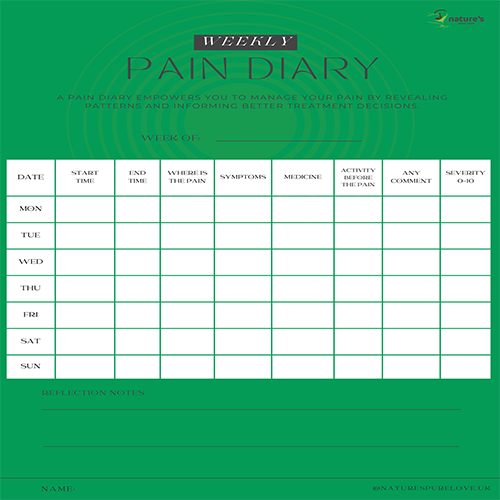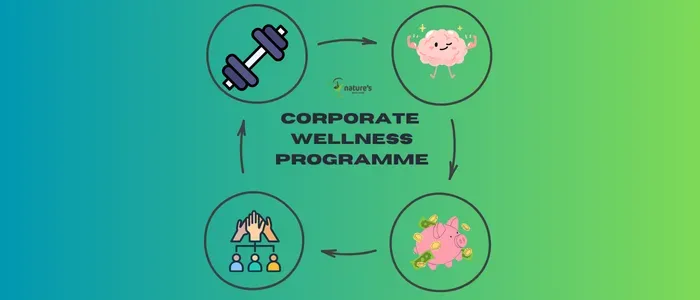Take Control of Your Pain with a Pain Diary
Pain Diary
Introduction:

Living with chronic pain can be overwhelming, impacting your sleep, mood, and daily activities. However, you have a powerful tool at your disposal - ‘the pain diary.’ This blog post delves into how a pain diary empowers you to understand your pain, manage it effectively, and ultimately regain control of your life.
What is a Pain Diary?
Imagine a personalised detective kit for your pain. A pain diary is a record where you log details about your pain experiences, helping you identify patterns, frequency, intensity, triggers, and the nature of your pain, along with influencing factors. This valuable information becomes the foundation for better pain management strategies. A pain diary is more than just a record.
Many individuals discover the therapeutic nature of maintaining a diary. Beyond serving as an emotional outlet and a tool for self-reflection, it can instil a sense of control and empowerment.
Practical Benefits:
- Comprehensive Overview: A pain diary provides a comprehensive overview of your condition over time. It helps you identify specific activities or events that exacerbate your pain, along with the strategies that proved effective.
- Enhanced Communication with Healthcare Professionals: The diary serves as a valuable memory tool for appointments, offering healthcare professionals a deeper understanding of your condition. This insight helps them evaluate the suitability of your current treatment plan.
Getting Started:
Choose a format that suits you! Some prefer handwritten notes in a notebook or journal, while others opt for digital methods on a computer or phone. The key is to choose something convenient and consistent.

What to Include:
Think of it as building a detailed picture of your pain journey. Include:
- Date and Time: Track pain episodes precisely.
- Pain Intensity: Use a numerical scale (0-10) with 0 being no pain and 10 being the worst imaginable.
- Location: Pinpoint the exact area(s) of pain.
- Pain Characteristics: Describe the pain (throbbing, burning, etc.).
- Treatments: Record medications, dosages, and side effects.
- Triggers and Relievers: Identify activities, food, or drinks that worsen or improve your pain.
- Sleep: Note if pain affects your sleep or vice versa.
- Mood: Track how your mood impacts your pain perception.
- Activities: Include the activities you did that day, sleep quality, medications taken, and their dosage.
- Positive Entries: Celebrate strategies that worked or things that lifted your mood.
Using Your Pain Diary:
- Track daily pain experiences, activities, emotions, and relief strategies.
- Regularly review entries to identify patterns and potential triggers.
- Share the diary with healthcare professionals to enhance understanding and treatment decisions.
Benefits of Keeping a Pain Diary:
- Gain valuable insights into your pain patterns and triggers.
- Facilitate clear communication with your doctor for personalised treatment plans.
- Identify and eliminate pain triggers, maximising treatment effectiveness.
- Proactive pain management empowers you to reclaim control and improve your overall well-being.
Tips for Keeping a Pain Diary:
- Be Consistent: Regular entries provide the most valuable data.
- Be Detailed: Capture as many specifics as possible about your pain and related factors.
- Be Honest: Accurate information is crucial for effective treatment.
- Tailor it to You: Include additional factors relevant to your unique pain experience.
- Share with Your Doctor: Discuss your diary entries during consultations.
Conclusion:
A pain diary is a powerful tool for you and your doctor to work together towards a life not limited by pain. Explore digital pain diary apps for added convenience and data analysis features. Remember, taking control of your pain starts with understanding it, and your pain diary is the key to unlocking that understanding.
Frequently Asked Questions (FAQs)
Q: What is a pain diary, and how does it help manage chronic pain?
A pain diary is a personal record of your pain experiences. It helps you track pain patterns, identify triggers, and communicate effectively with healthcare providers, leading to improved pain management.
Is there a right or wrong way to keep a pain diary?
There's no strict rule. The most effective pain diary is the one you'll stick to. Be consistent and include details that matter to you.
How long should I keep a pain diary?
Ideally, you should maintain a pain diary consistently to identify patterns. However, even short-term records can be valuable for discussing with your doctor.
What should I include in my pain diary?
Include pain intensity, location, duration, triggers, medications, mood, sleep, and any activities or treatments that seem to affect your pain.
How often should I make entries in my pain diary?
Daily entries are best for capturing pain patterns. However, if daily entries are overwhelming, start with tracking pain on specific days or during flare-ups.
How do I measure pain intensity?
Use a pain scale of 0-10, with 0 being no pain and 10 being the worst imaginable pain. This helps track changes in pain severity over time.
How can I stay motivated to keep a pain diary?
Set reminders, find a journaling method you enjoy (digital or physical), and focus on the benefits of tracking your pain.
Are there any pain diary apps available?
Yes, several pain diary apps offer features like tracking, reminders, and data analysis. Research to find one that suits your needs.










